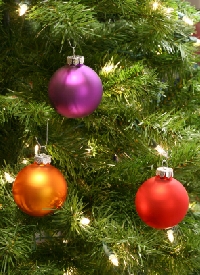
Learn how to return your tree to the natural world after the holidays.
Choosing a Christmas tree requires some thought. Many shoppers feel a brief twinge bringing a recently-living tree into the living-room and a stronger twinge carrying the same tree out to the curb for refuse pickup. What else is there to do with a Christmas tree after Christmas?
Recycle Your Tree
You can recycle your Christmas tree, giving it good care while you are enjoying it and then returning it to the natural world. The garden center or tree lot where you buy your tree can guide you on providing a good indoor location, watering and other tips to make your tree last. Often they can also help you choose the best variety of tree for your warm apartment, heavily-used family room or very sunny living room.
Once the holiday has passed, carry your tree to the back porch or the yard not to the curb. To recycle your Christmas tree, you need:
- Lopping shears or heavy clippers
- Old newspapers
- Peanut butter, soft tub margarine, or white shortening
- Bird-seed, peanuts, raisins, other dried fruits or nuts, stale popcorn (any or all)
- Leftover Christmas ribbon (optional)
Spread small branches with peanut butter, margarine or white shortening. Then dip it in bird seed. This provides wonderful, renewable feeders for birds. Tie them to bare tree branches with leftover Christmas ribbon. Heavy rain or snow will wash away some of your efforts; just spread and dip again. Children love making these and deciding when the feeders need renewing. The only supplies needed are peanut butter or shortening, seed and lots of newspapers to keep the project within bounds.
If you haven’t put up a bird-feeder before, be prepared to wait a few days until your new food source is spotted. Word will get around, and you and your children will have a great time learning about your feathered visitors. If possible, keep your feeders going until spring is well under way; the end of winter and early spring are hungry times for birds.
Recycling Large Branches
Large branches have a natural curve that make them ideal protectors for perennials. Turn the branches over and build Christmas-tree igloos over the roots of roses, berries and other tender perennials to protect them from ice-storm damage. Overlap branches, leaving spaces for rain or snow to get through. Pile branches at least a foot high, taking particular care to shelter graft-stocks from ice.
~
Recycling the Trunk
Cut a two-foot section of trunk from the top of your Christmas tree to make a squirrel feeder. The short stubs from cut-off branches make this a natural squirrel gym. Prepare your squirrel feeder the same way you did your bird feeder. You can add small chunks of apple, orange or other fruit. Stick your squirrel feeder directly into the garden. If the ground is frozen hard, prop it against a tree, wall or other garden support, or stand it in an empty flower-pot.
Cut the remaining trunk into firewood-sized pieces and store in a dry place. Seasoned, they will provide the basis for next year’s first Christmas-season fire. If you don’t use your fireplace, tie a ribbon around your tree-trunk pieces; they make a thoughtful gift to someone who loves a cozy winter fire.
Thus your whole Christmas tree can be returned to the natural world. Your perennials will weather the ice storms that hit many regions in January and February. Local birds and squirrels will enjoy their feeders especially when the ground is covered with snow even if there is little or no snow. Getting enough food to endure winter cold is a big job for birds and animals. And your family or another will add one more tradition to your holiday celebration: starting the first fire of the Christmas season with wood from last year’s tree.

